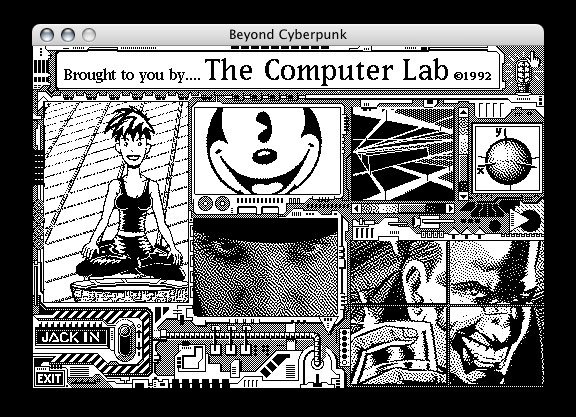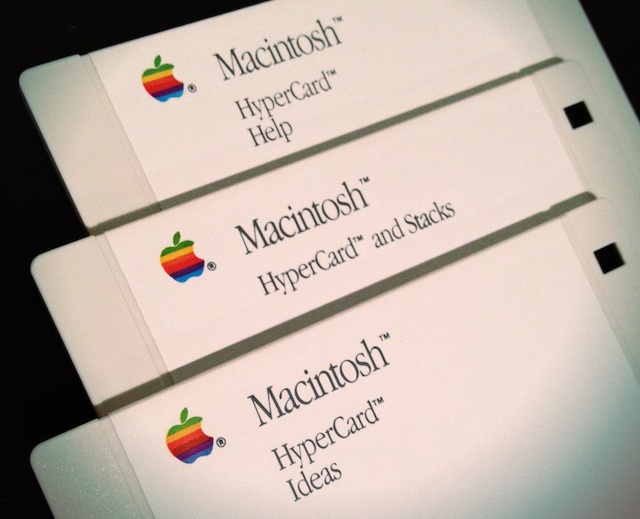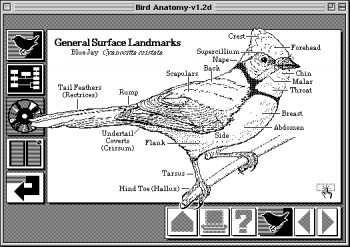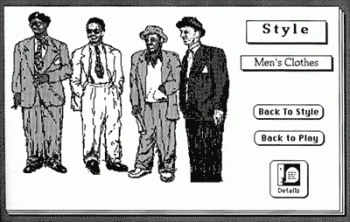
Sometime around 1988, my landlady and I cut a deal. She would purchase a Macintosh computer, I would buy an external hard drive, and we would leave the system in the living room to share. She used the device most, since I did my computing on an IBM 286 and just wanted to keep up with Apple developments. But after we set up the Mac, I sat down with it one evening and noticed a program on the applications menu. "HyperCard?" I wondered. "What's that?"
I opened the app and read the instructions. HyperCard allowed you to create "stacks" of cards, which were visual pages on a Macintosh screen. You could insert "fields" into these cards that showed text, tables, or even images. You could install "buttons" that linked individual cards within the stack to each other and that played various sounds as the user clicked them, mostly notably a "boing" clip that to this day I can't get out of my mind. You could also turn your own pictures into buttons.
Not only that, but HyperCard included a scripting language called "Hyper Talk" that a non-programmer like myself could easily learn. It allowed developers to insert commands like "go to" or "play sound" or "dissolve" into the components of a HyperCard array.
Intrigued, I began composing stacks. None of them amounted to anything more than doodle-packed matrices of images, sounds, and aphorisms, but I eventually glanced at my wrist watch. It was 4:00 AM. Startled and quite tired, I turned in with visions of stack buttons dancing in my head.
This month, I glanced at my historical watch. HyperCard will soon be 25, I noticed [Editor's Note: In 2019, it'll turn 32!]. What ever happened to it? I searched around and found venture entrepreneur and coder Tim Oren's 2004 eulogy for the program, written the week that Apple withdrew the software from the market. HyperCard's problem, he argued, was that Apple never quite figured out what the software was for.
"What was this thing?" Oren wrote. "Programming and user interface design tool? Lightweight database and hypertext document management system? Multimedia authoring environment? Apple never answered that question."
And so the Cupertino company exiled the program to its Claris subsidiary, where it got lost amidst more prominent projects like Filemaker and the ClarisWorks office suite. "Hard core supporters, particularly from the educational community, kept it alive when Apple reabsorbed Claris, but only on sufferance," Oren's epitaph continued.
Even before its cancellation, HyperCard's inventor saw the end coming. In an angst-filled 2002 interview, Bill Atkinson confessed to his Big Mistake. If only he had figured out that stacks could be linked through cyberspace, and not just installed on a particular desktop, things would have been different.
"I missed the mark with HyperCard," Atkinson lamented. "I grew up in a box-centric culture at Apple. If I'd grown up in a network-centric culture, like Sun, HyperCard might have been the first Web browser. My blind spot at Apple prevented me from making HyperCard the first Web browser."
HyperCard may not have been the first Web client, but as the anniversary of its release approaches, I think that it deserves a more prominent place in the history of the Internet.
Computer lib

The year of HyperCard's unveiling, the San Francisco-based television show Computer Chronicles produced a program about the software. The hosts of the episode very quickly identified the program's inspiration.
"HyperCard is based upon hypertext," Gary Kildall told Stewart Cheifet. "It's a concept that was developed by Ted Nelson and Doug Engelbart in the sixties. The basic idea is this: if we're trying to do research on any kind of a subject, the subject matter exists in all kinds of different places. It can be books, magazines, tape recordings, Compuserve, and if we can somehow link all this stuff electronically, so that if we click on Beethoven, we can all of a sudden jump from one to the next... that's what hypertext is all about."

Theodore Nelson had proposed the hypertext concept as early as 1960 and tried to implemented it in his never-finished Project Xanadu. Undaunted, Nelson morphed into an eloquent evangelist for the idea. In his 1974 book, Computer Lib/Dream Machines, he defined hypertext as "forms of writing which branch or perform on request; they are best presented on computer display screens." By simplifying the process of dispersing and accessing information, hypertext and hypermedia could liberate society from what Nelson saw as an overprofessionalized digital information elite.

"As the saying goes, war is too important to be left to the generals," Nelson wrote. "Guardianship of the computer can no longer be left to a priesthood."
But the "priesthood" was actually doing a pretty good job of cutting the technology loose in the 1970s. Three years before the release of Computer Lib, the architects of ARPANET—the Defense Department's prototype version of the Internet—unveiled their project at a public event in Washington, DC. Meanwhile two engineers at AT&T's Bell Labs busily worked on UNIX, the operating system that would become the backbone of the 'Net. Fearing antitrust reprisals from the government if it strayed into the software marketing business, AT&T leased UNIX to colleges and universities at bargain basement rates. Those schools, supported by grants from the National Science Foundation, built hundreds and then thousands of ARPANET "nodes" through the 1980s.
This took the Internet to 1989, when a programmer at CERN, Switzerland's huge physics laboratory, proposed some kind of hypertext network for use at the site.
"Most systems available today use a single database," Tim Berners-Lee explained. "This is accessed by many users by using a distributed file system. There are few products which take Ted Nelson's idea of a wide 'docuverse' literally by allowing links between nodes in different databases."
But Berners-Lee was determined to build one.
reader comments
230